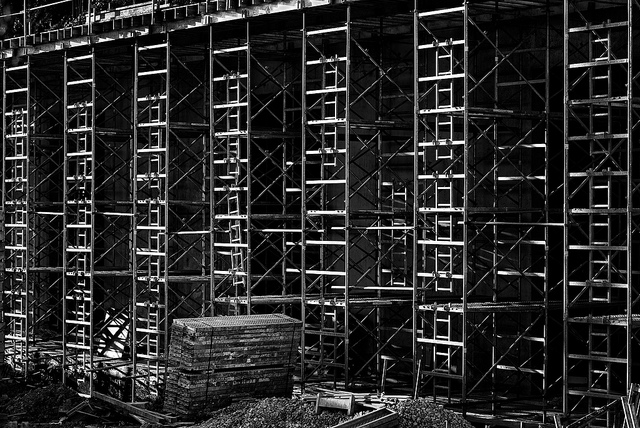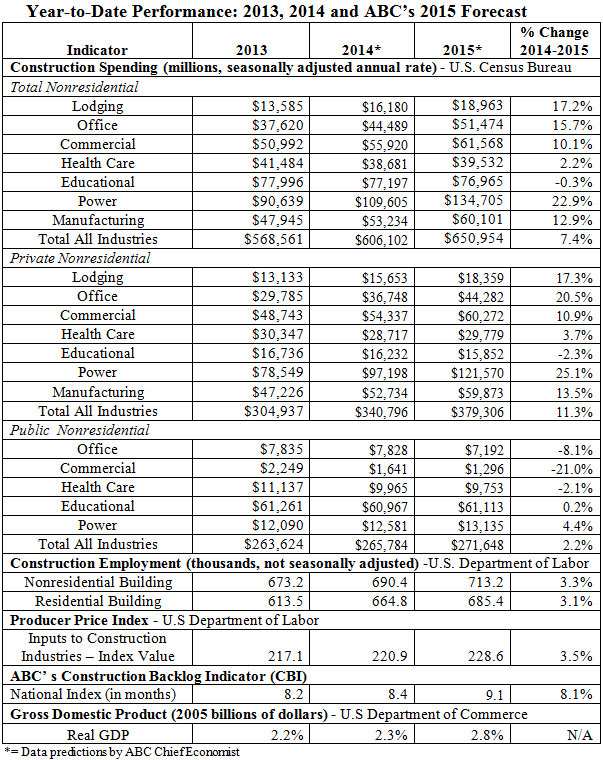Associated Builders and Contractors (ABC) forecasts a steady and ongoing economic recovery for the U.S. commercial and industrial construction industries in 2015. The reasonably brisk industry recovery in 2014 should continue in 2015, with momentum especially growing in segments closely related to the current American energy and industrial production resurgence.
"ABC forecasts nonresidential construction spending will expand by roughly 7.5% next year," said ABC Chief Economist Anirban Basu. "The segments that will experience the largest growth in construction spending in 2015 include power (e.g. natural gas-related construction), lodging (leisure and business spending), office space (professional services employment creation) and manufacturing (rebounding industrial production).
"The public sector will see far more sluggish growth in construction spending," Basu warned. "However, this fits a multi-year pattern with private nonresidential spending exceeding public nonresidential spending by 28% in 2014, up from 15.6 percent in 2013.
"There are always issues, of course, including compensation costs that will rise more quickly per worker next year than in years past," Basu cautioned. "This will be particularly apparent in areas like Louisiana and Northern California, places that have experienced significant economic growth recently. Additionally, while material price inflation has been suppressed, it may accelerate in 2015. Last year, prices were suppressed due to a combination of factors, such as softer growth in most of Europe and Asia, rising energy production here in the U.S., and a stronger dollar. Some of these factors might not be as prominent next year, so the stage could be set for price increases close to 3 percent.
"Taking into account current economic momentum, especially in the form of employment growth, ongoing accommodative monetary policy and increased growth in consumer spending, further stoked by falling gasoline prices, 2015 should be a decent one for the U.S. economy," said Basu. "Contractors should continue to experience a lengthening backlog and the industry should continue to see increases in nonresidential construction spending and employment growth."
Related Stories
| Mar 2, 2011
How skyscrapers can save the city
Besides making cities more affordable and architecturally interesting, tall buildings are greener than sprawl, and they foster social capital and creativity. Yet some urban planners and preservationists seem to have a misplaced fear of heights that yields damaging restrictions on how tall a building can be. From New York to Paris to Mumbai, there’s a powerful case for building up, not out.
| Mar 1, 2011
Smart cities: getting greener and making money doing it
The Global Green Cities of the 21st Century conference in San Francisco is filled with mayors, architects, academics, consultants, and financial types all struggling to understand the process of building smarter, greener cities on a scale that's practically unimaginable—and make money doing it.
| Mar 1, 2011
How to make rentals more attractive as the American dream evolves, adapts
Roger K. Lewis, architect and professor emeritus of architecture at the University of Maryland, writes in the Washington Post about the rising market demand for rental housing and how Building Teams can make these properties a desirable choice for consumer, not just an economically prudent and necessary one.
| Mar 1, 2011
New survey shows shifts in hospital construction projects
America’s hospitals and health systems are focusing more on renovation or expansion than new construction, according to a new survey conducted by Health Facilities Management magazine and the American Society for Healthcare Engineering (ASHE). In fact, renovation or expansion accounted for 73% of construction projects at hospitals responding to the survey.
| Mar 1, 2011
AIA selects 6 communities for long-term sustainability program
The American Institute of Architects today announced it has selected 6 communities throughout the country to receive technical assistance under the Sustainable Design Assessment Team (SDAT) program in 2011. The communities selected are Shelburne, Vt., Apple Valley, Mn., Pikes Peak Region, Co., Southwest DeKalb County, Ga., Bastrop, Tx., and Santa Rosa, Ca. The SDAT program represents a significant institutional investment by the AIA in public service work to assist communities in developing policy frameworks and long term sustainability plans.
| Feb 24, 2011
Perkins+Will designs 100 LEED Certified buildings
Perkins+Will announced the Leadership in Energy and Environmental Design (LEED) certification of its 100th sustainable building, marking a key milestone for the firm and for the sustainable design industry. The Vancouver-based Dockside Green Phase Two Balance project marks the firm’s 100th LEED certified building and is tied for the highest scoring LEED building worldwide with its sister project, Dockside Green Phase One.
| Feb 24, 2011
New reports chart path to net-zero-energy commercial buildings
Two new reports from the Zero Energy Commercial Buildings Consortium (CBC) on achieving net-zero-energy use in commercial buildings say that high levels of energy efficiency are the first, largest, and most important step on the way to net-zero.
| Feb 24, 2011
Lending revives stalled projects
An influx of fresh capital into U.S. commercial real estate is bringing some long-stalled development projects back to life and launching new construction of apartments, office buildings and shopping centers, according to a Wall Street Journal article.
| Feb 23, 2011
London 2012: What Olympic Park looks like today
London 2012 released a series of aerial images that show progress at Olympic Park, including a completed roof on the stadium (where seats are already installed), tile work at the aquatic centre, and structural work complete on more than a quarter of residential projects at Olympic Village.
| Feb 23, 2011
Call for Entries: 2011 Building Team Awards, Deadline: March 25, 2011
The 14th Annual Building Team Awards recognizes newly built projects that exhibit architectural and construction excellence—and best exemplify the collaboration of the Building Team, including the owner, architect, engineer, and contractor.











